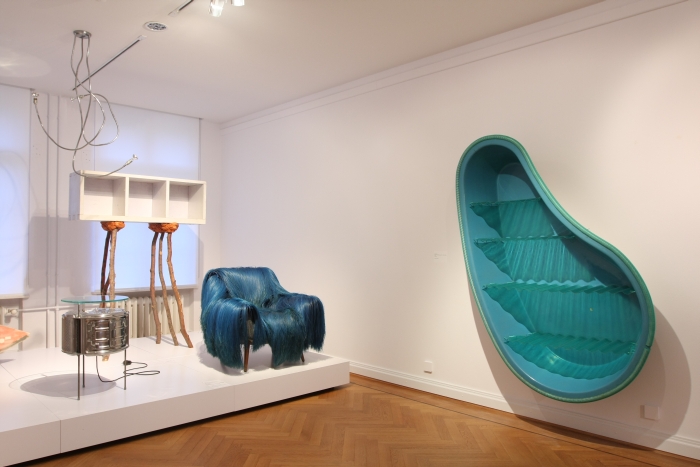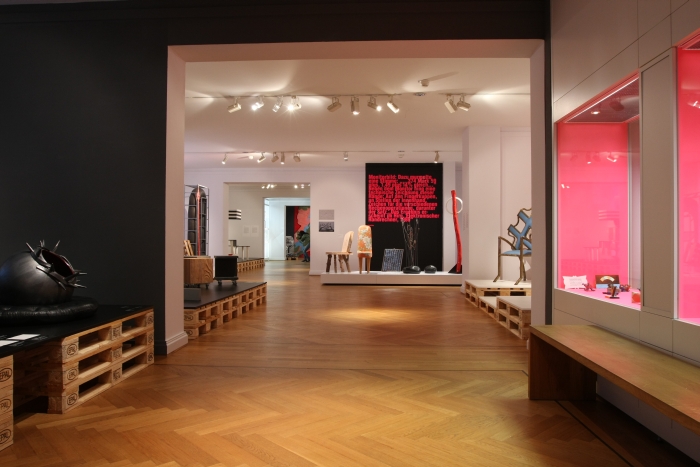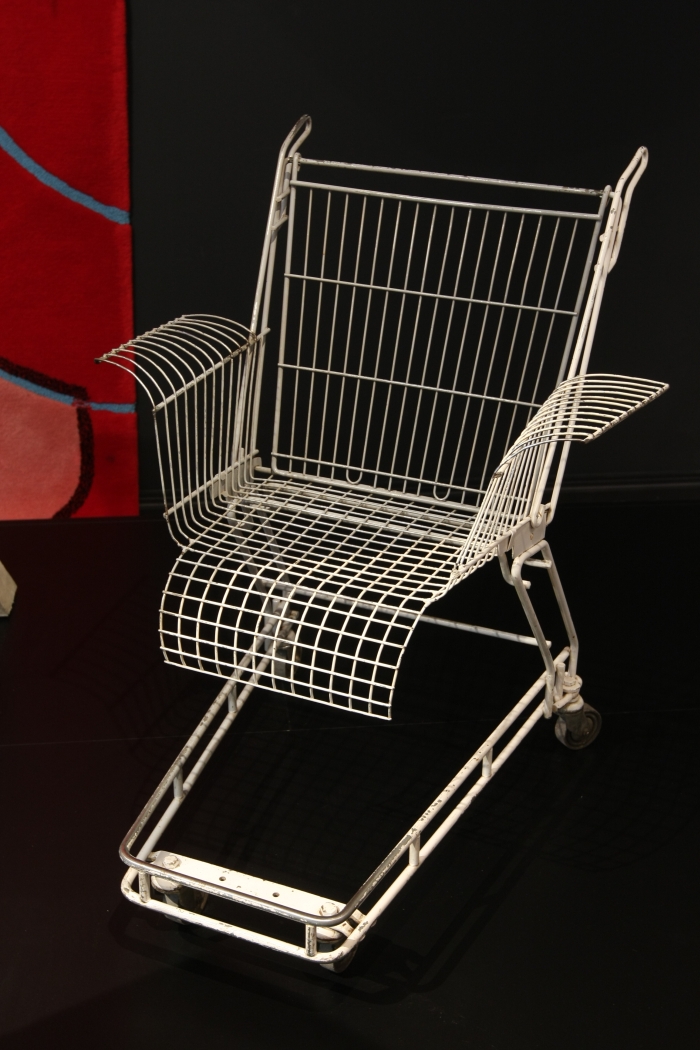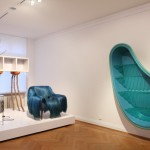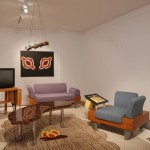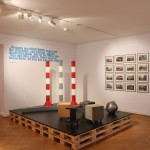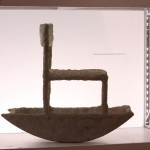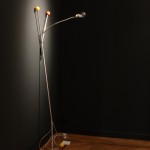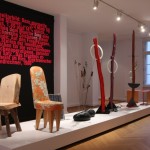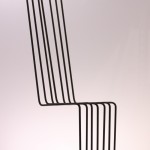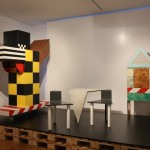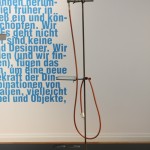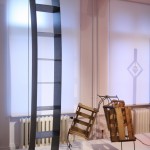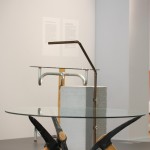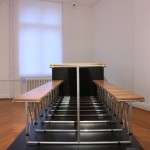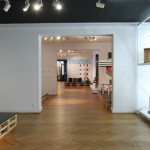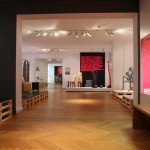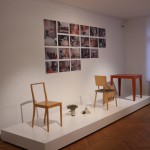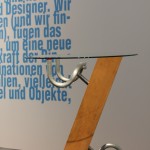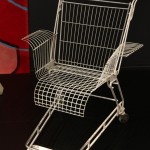Schrill Bizarr Brachial. Das Neue Deutsche Design der 80er Jahre at the Bröhan Museum Berlin
“Marcel Breuer seeing a pair of bicycle handle-bars decided to make chairs using the same industrial process. The new world constructor seeing a pair of bicycle handle-bars decides to use them as they are and save himself the trouble and expense of bending the tube.”1
So articulated Jasper Morrison in his 1984 text “The Poet will not Polish” not only the theoretical background to his Handlebar Table, but much more the frustration and alienation being felt at that time by a young generation of European artists, architects and designers to and with the existing systems and the accepted cultural norms. A lack of faith if you will in industrial society’s ability to provide that what the population actually needed and wanted. And that the functionalists were largely to blame for the current unhappy state of affairs.
Morrison’s text appeared in the catalogue to the exhibition Kaufhaus des Ostens – Department Store of the East – an exhibition organised by Joachim Stanitzek and Andreas Brandolini, ably assisted by Jasper Morrison, and which presented works by students from the Hochschule der Künste Berlin. Kaufhaus des Ostens arose from a project in which students were asked to create furniture and/or household objects from items available at the local building centre; the idea being to stick two fingers up to the industrial producers by designing without designing, to take industry’s carefully created products and give them a new, alien, function. The rules for the students were simple: they could spend a maximum of 100DM and had one week to complete the project. Although essentially nothing more spectacular than the presentation of a student project, Kaufhaus des Ostens had a second, ulterior, motive, one which touched a creative nerve: the subtitle of the project takes the “KdO” abbreviation of Kaufhaus des Ostens to create “Kampf der Ohnmacht” – fight the impotence – and thus can be understood as a call to reject the status quo, to explore new ways producing, of living, of understanding the world around you. Consequently Kaufhaus des Ostens was one of the defining moments in the so called Neue Deutsche Design – New German Design – movement of the 1980s. Italy had the Memphis group of Ettore Sottsass, Michele de Lucchi, Alessandro Mendini et al fighting postmodernism’s corner. Germany had Kaufhaus des Ostens, Möbel perdu, Bellefast, Kunstflug et al. And the Bröhan Museum in Berlin is currently celebrating these radical young things and their contribution to the history of German design with the exhibition “Schrill Bizarr Brachial. Das Neue Deutsche Design der 80er Jahre” [Fancy Bizarre Brutal. New German Design of the 1980s]
The first exhibit one sees on entering Schrill Bizarr Brachial is Morrison’s Handlebar Table, presented as part of a display devoted to Kaufhaus des Ostens. Jasper Morrison himself was not technically a student at the Hochschule der Künste in 1984, was however in Berlin, was very friendly with Andreas Brandolini and so was invited not only to participate, but to co-curate the exhibition. Similarly, Morrison had already created his Handlebar Table in 1983 and had, in effect, brought it with him as part of his luggage to Berlin; however, as it fitted with the philosophy of the exhibition he was allowed to present it. In addition to the Handlebar Table Morrison also contributed other projects to Kaufhaus des Ostens, projects which did meet the rules including “Directional Lamp with small table”, essentially a light bulb in a plastic filter funnel on a metal stand, and an object which can enjoyed in all its perverse yet persuasive glory in the Bröhan Museum. Further Kaufhaus des Ostens projects featured in Schrill Bizarr Brachial include John H. Hirschberg’s sideboard made from brick layer’s trowels, Axel Stumpf’s axe and glass coffee table Kumpel II and Bettina Wiegandt and Manuel Pfahl’s sheet zinc stool and side table.
The decision to, in effect, open the exhibition with Kaufhaus des Ostens is deliberate: Kaufhaus des Ostens is in many ways the inspiration for Schrill Bizarr Brachial. Not only did the show première in Berlin thirty years ago, but was last presented in 1985 in the building that now houses the Bröhan Museum, albeit in the then resident Werkbundarchiv.
That the Bröhan Museum is the Berlin State Museum for Art Deco, Art Nouveau and Functionalism one could see a slight contradiction in the institution presenting an exhibition devoted to Neue Deutsche Design; museum director and exhibition curator Tobias Hoffmann doesn’t, “I want to use our special exhibitions to further expand our classic focus, that is present exhibitions that perhaps lie outwith our core period of 1890 and 1940, yet exhibitions which have a connection to our classic themes,” explains Dr Hoffmann, “and this exhibition has two connections. Firstly the local connection, and secondly from an artistic aspect the objects shown here repeat what Art Nouveau stood for, namely searching for creative freedom, to create objects which can remain as one-offs, to not always think about serial production, about industrial production. This longing for the industrial production plays a central role in history of German design, be that with Bauhaus, with the Hochschule für Gestaltung Ulm or with gute Form. And with both Art Nouveau and the Neue Deutsche Design we break completely from this thinking.”
To demonstrate this search for a brave, new future Schrill Bizarr Brachial presents, in addition to Kaufhaus des Ostens, collections of works by key protagonists of the era, including, for example, the Berlin based Bellefast collective of Andreas Brandolini, Joachim Stanitzek and Max Moormann, or Pentagon from Cologne featuring Wolfgang Laubersheimer, Reinhard Müller and Ralph Sommer, in addition to individual designers and artists such as Axel Kufus, Volker Albus or Siegfried Michail Syniuga. In addition the exhibition recreates Andreas Brandolini’s 1987 “Deutsche Wohnzimmer” – German Living Room – installation from the Documenta 8 art festival and presents an original ensemble from Hamburg Galerie Möbel perdu – including a video of the opening of the 1982 exhibition “Möbel perdu – Schöneres Wohnen”, an exhibition that is generally considered to mark the “awakening” of Neue Deutsche Design as a tangible, definable movement.
What Schrill Bizarr Brachial makes very clear is not only was Neue Deutsche Design a geographically diverse movement, but in no way was it a movement defined by a unified style or approach. Everyone was doing their own thing, some with a more artistic approach, some more design, but all looking in the same direction and all with the same ideals and fervour. A state of affairs that had its origins in the way the movement came together and organic way it evolved. “The protagonists generally began independently from one another, often without even being aware of one another”, explains Tobias Hoffmann, “but after the first exhibitions they very quickly became aware of one another and then started to cooperate, staged joint exhibitions and attempted to help one another”
A situation that almost perfectly describes the path taken by the artist known as Stiletto Studios. Stiletto moved to Berlin in 1980 and after initial experimentation with photography and film moved on to furniture. With his 1983 Consumer’s Rest Lounge Chair Stiletto created one of the true pin up pieces of the era, a work which attracted a lot of media attention thus helping others find publicity and a work which has since gone on to be included in the permanent collection of numerous leading design museums including the Vitra Design Museum, the V&A London, and the Cooper Hewitt, Smithsonian Design Museum in New York.
“Shortly after I moved to Berlin I realised that I couldn’t see myself as a regular worker in the industrial society, realised my studies were the wrong choice and so I made a radical cut, ditched everything and submerged myself in the Berlin post punk world. As often as I could afford it I would go to the club Jungle which was where all the Berlin subcultures met, also the designers an artists.”, explains Stiletto, “Initially I had nothing to do with design, didn’t know anything about any scene and certainly wasn’t aware that there were people exploring design with an artistic, critical or analytical approach. However that quickly changed, I made ever more contacts, and became more involved. My first works were produced in 1981, but it was 1982 before I started working conscientiously, and there then followed a period of one maybe one and half years where I worked very intensely in context of design, for example with readymade, bricolage and similar concepts”
And it is fortunate that he was there when he was, for just as quickly as it rose, so vanished Neue Deutsche Design. “The exhibition “Wohnen von Sinnen” in Düsseldorf in 1986 was the grandiose highpoint, the biggest and most important exhibition and then very quickly afterwards it cooled and became much weaker.” says Dr Hoffmann. The reasons why are probably as numerous as the protagonists, but ultimately the final death knell fell with the Berlin Wall in 1989 and subsequent German unification. The resultant social, political and cultural changes creating new conditions, new challenges, new realities, new associations and a need for new responses.
Given the divergent nature of the protagonists, the fact that Neue Deutsche Design effectively lasted less than a decade and the social and cultural changes that have occurred since the 1980s, the one question that dominates your thoughts as you view Schrill Bizarr Brachial is, can one speak of a legacy? “Formally there are very few connections that can be made”, answers Tobias Hoffmann, “however, in terms of content definitely. When one, for example, looks at the current maker scene, especially here in Berlin, that is exactly what began in the 1980s, this idea of taking things in your own hands, establishing small galleries and generally taking control over the design, production and distribution processes.” But Neue Deutsche Design survives in other ways: in more open, experimental relationships with materials, the ill advised readymades which blight so many an otherwise good design exhibition, and also in a number of newer furniture producers who took up many of the ideals of the time and have absorbed them into the company philosophy. Whereas a company such as Cappellini in their current form can be understood as a direct consequence of Memphis and the cultural upheavals in 1980s Italy, so to can a manufacturer such as Nils Holger Moormann be seen and understood in context of the experiences of Neue Deutsche Design, and more recently Pulpo, a company who for us make decisions based on emotional gut feelings as much as any considered commercial interest.
But for us the most lasting, most durable, and perhaps also most important influence of Neue Deutsche Design is to be found in the German design education system: Axel Kufus and Inge Sommer at the Universität der Künste Berlin, Volker Albus at the Hochschule für Gestaltung Karlsruhe, Ralph Sommer at the HFBK Hamburg, Wolfgang Laubersheimer at the Köln International School of Design and Jörg Hundertpfund at the FH Potsdam, amongst others, all coming from Neue Deutsche Design. And all who not only attempt to install a principle of experimental free thinking in their students but who approach their teaching work now with the same panache and passion as their design work then.
An excellently designed and constructed exhibition Schrill Bizarr Brachial mixes design objects with film, photography and short texts to present a very open and accessible introduction to a period in German design history that was perhaps more fun to be part of than to look back on, which definitely missed its aim of destroying the established design traditions, but which did usher in a new approach to design thinking and opened new possibilities for design, made design something that was culturally relevant and not just commercially important, and for which we should all be thankful.
As such for all wanting to understand 20th century German design beyond Bauhaus, Dieter Rams and Egon Eiermann it is an exhibition well worth visiting.
Schrill Bizarr Brachial. Das Neue Deutsche Design der 80er Jahre runs at the Bröhan Museum until Sunday February 1st.
The exhibition texts are – almost – all bilingual German/English and full details, including information on the accompanying fringe programme, can be found at www.broehan-museum.de
1.Kaufhaus des Ostens, Catalogue, c kdo + verlag zweitschrift, Hannover 1984
- Schrill Bizarr Brachial. Das Neue Deutsche Design der 80er Jahre, Bröhan Museum Berlin
- Deutsche Wohnzimmer by Andreas Brandolini, as seen at Schrill Bizarr Brachial. Das Neue Deutsche Design der 80er Jahre, Bröhan Museum Berlin
- Selected works by Volker Albus, as seen at Schrill Bizarr Brachial. Das Neue Deutsche Design der 80er Jahre, Bröhan Museum Berlin
- Rocking Chair by Stiletto Studios, as seen at Schrill Bizarr Brachial. Das Neue Deutsche Design der 80er Jahre, Bröhan Museum Berlin
- Mein bester Freund (die gute Form) by Florian Aicher, as seen at Schrill Bizarr Brachial. Das Neue Deutsche Design der 80er Jahre, Bröhan Museum Berlin
- Selected works by the collective Kunstflug, as seen at Schrill Bizarr Brachial. Das Neue Deutsche Design der 80er Jahre, Bröhan Museum Berlin
- Solid by Heinz H Landes, as seen at Schrill Bizarr Brachial. Das Neue Deutsche Design der 80er Jahre, Bröhan Museum Berlin
- Selected works by Bellefast, as seen at Schrill Bizarr Brachial. Das Neue Deutsche Design der 80er Jahre, Bröhan Museum Berlin
- Directional Lamp with small table by Jasper Morrison, as seen at Schrill Bizarr Brachial. Das Neue Deutsche Design der 80er Jahre, Bröhan Museum Berlin
- Verspanntes Regal by Wolfgang Laubersheimer and Mai ’68 by Detlef Meyer Voggenreither, as seen at Schrill Bizarr Brachial. Das Neue Deutsche Design der 80er Jahre, Bröhan Museum Berlin
- Kumpel II by Axel Stumpf, as seen at Schrill Bizarr Brachial. Das Neue Deutsche Design der 80er Jahre, Bröhan Museum Berlin
- Tabula Rasa by Ginbande, as seen at Schrill Bizarr Brachial. Das Neue Deutsche Design der 80er Jahre, Bröhan Museum Berlin
- Lichterstrauss & Litzenlampe by Axel Kufus Ulrike Holthöfer, as seen at Schrill Bizarr Brachial. Das Neue Deutsche Design der 80er Jahre, Bröhan Museum Berlin
- Schrill Bizarr Brachial. Das Neue Deutsche Design der 80er Jahre, Bröhan Museum Berlin
- Schrill Bizarr Brachial. Das Neue Deutsche Design der 80er Jahre, Bröhan Museum Berlin
- A selection of works by Jasper Morrison and Axel Kufus, as seen at Schrill Bizarr Brachial. Das Neue Deutsche Design der 80er Jahre, Bröhan Museum Berlin
- Handlebar Table by Jasper Morrison, as seen at Schrill Bizarr Brachial. Das Neue Deutsche Design der 80er Jahre, Bröhan Museum Berlin
- Consumer’s Rest by Stiletto Studios, as seen at Schrill Bizarr Brachial. Das Neue Deutsche Design der 80er Jahre, Bröhan Museum Berlin
Tagged with: Axel Kufus, Berlin, Bröhan Museum, Jasper Morrison, Neue Deutsche Design, Schrill Bizarr Brachial. Das Neue Deutsche Design der 80er Jahre, Stiletto, Wolfgang Laubersheimer
